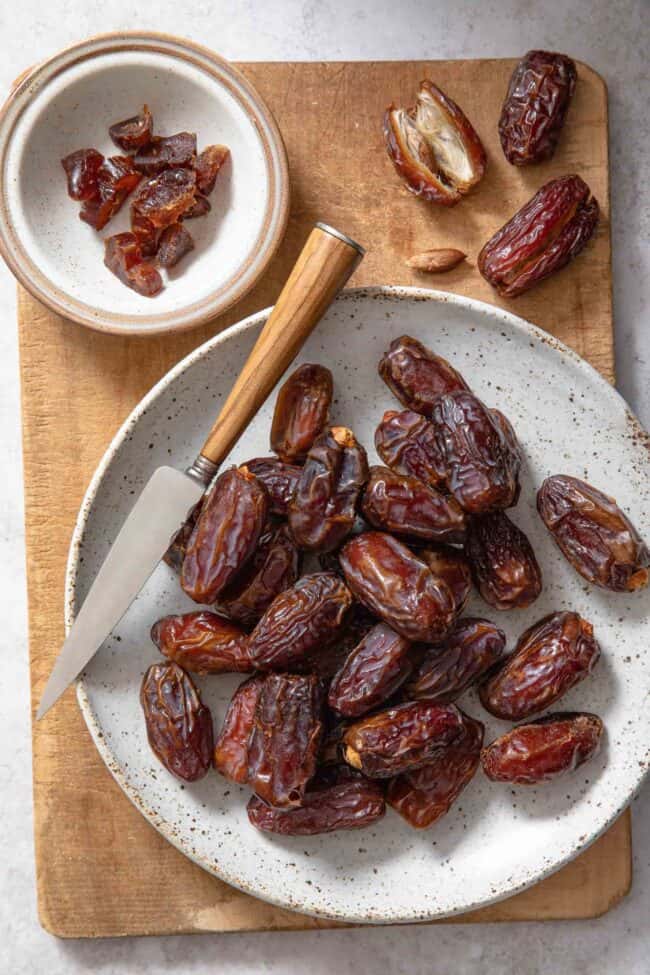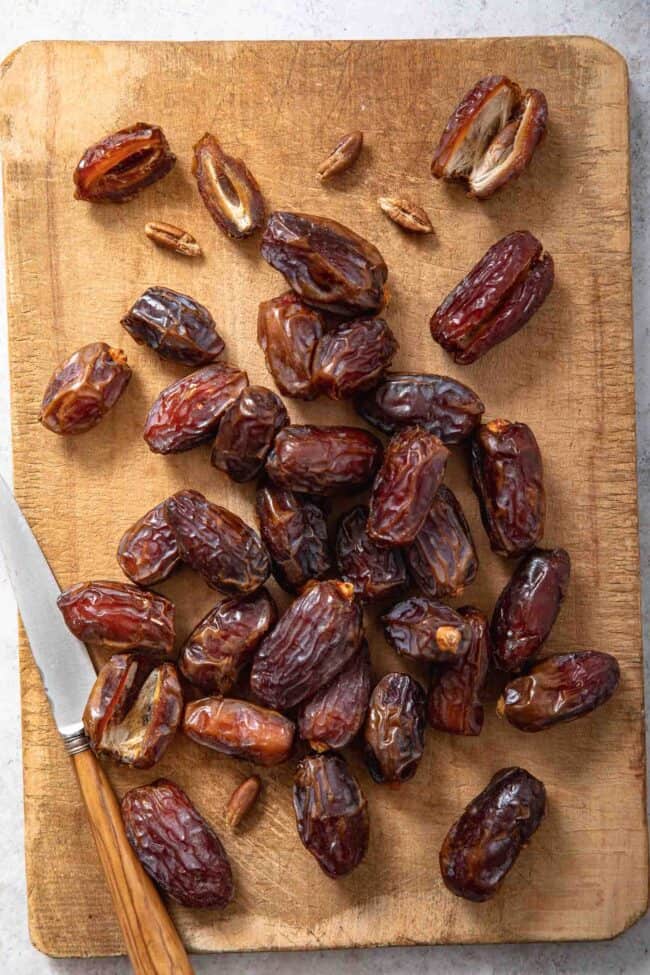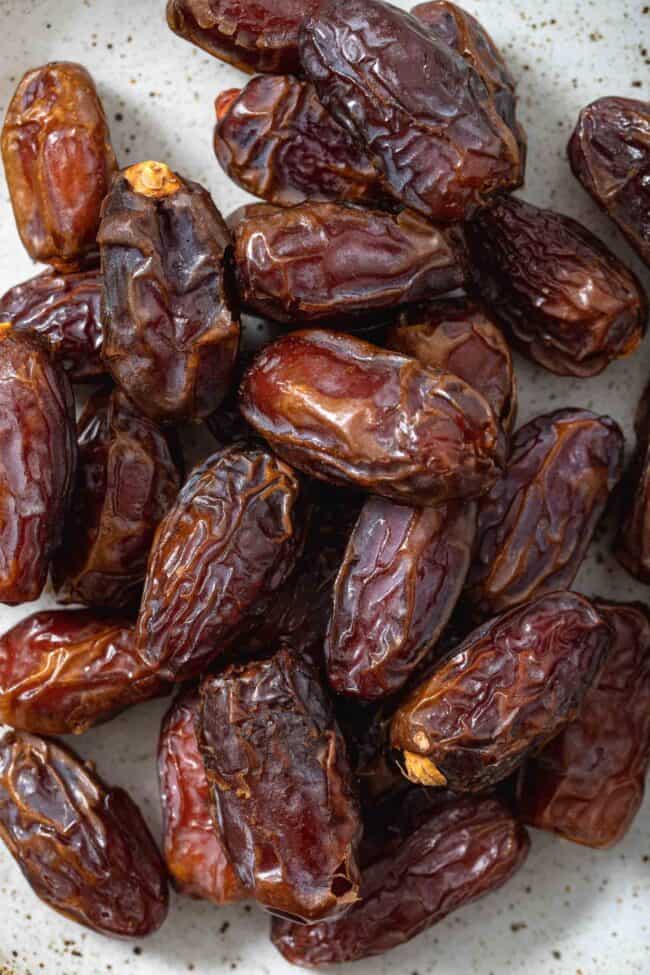Dates
Dried and fresh dates (date fruit) are soft, sweet, sticky and chewy. They’re often referred to as natures candy. They have a rich caramel-like flavor and they make a great natural sweetener. Here’s everything you need to know about date fruit, including Medjool dates, dates vs figs, dates vs prunes, plus some recipes to help you incorporate more of them into your daily wellness plan.

Dates are a small fruit and with up to 70% of their weight coming from sugar, they’re one of the sweetest fruits in the world.
What is a Date Fruit?
They grow at the tops of large date palm trees in heavy clusters of oblong brown fruits. There can be up to 200 dates in each cluster and each cluster can weight up to 25 pounds. The word “date” comes from the Greek word daktulos which refers to its shape and means “finger”.
They are a type of stone fruit similar to peaches, plums and cherries. Stone fruits are classified as drupes, which means they’re a type of fruit with a thin skin and a stone in the center which contains a seed.
They’re are sold as both fresh dates and dried dates, and it’s not that easy to tell the difference between the two. Fresh dates tend to be plumper and lighter in color and dried dates tend to be a bit darker with a more shriveled skin. Fresh dates have a lower glycemic index than dried dates, so they have a more mild impact on your blood sugar levels. Lower glycemic foods promote good energy levels and appetite control between meals. This is probably why dates are so often used when making energy balls. And dried dates tend to be sweeter than fresh dates.
Types of Dates
They are classified into three categories, soft, semi-soft and dry according to the texture of the fruit. The dry variety haven’t been dehydrated (like other fruits), they just contain very little moisture when ripe. You’ll likely find them at your local health food store.
- Barhi – This variety is a medium-sized fruit with a thin skin and soft tender flesh.
- Deglet Noor – This is the variety that is most often available. The color ranges from light red to amber.
- Halawy – These have a thicker skin with a firm flesh with buttery caramel-like flavor. The skin is wrinkled and the color ranges from yellow to amber.
- Khadrawy – These are similar to the Halawy variety. Soft flesh with a caramel-like flavor.
- Medjool – Medjool dates are probably the most common variety is the medjool date. Medjool dates are semi-soft dates (often referred to as the Cadillac of dates) are moist with a firm texture. Medjool dates are a little larger and have a richer caramel-like flavor than the other varieties.
- Theory – This is a dry firm and chewy date.
- Zahidi – The Zahidi is also called “Nobility”. It’s a semisoft variety with a large seed and crunch fibrous flesh, It’s often processed for date sugar products.
Where Do They Come From?
They’re native to the Middle East and have been cultivated for thousands of years. Much of the world’s date crop is grown in the Middle East, however, they’re now grown in many tropical regions around the world. The United States began producing them back in the early 1900s with most of them coming from California and Arizona.
Choosing the Best
Both fresh dates and dry dates should be smooth-skinned, plump and glossy. Avoid those that are broken, cracked, dry or shriveled. You also want to avoid them if they smell sour or have a crystallized sugar coating on their surface.
Date Fruit Season
Typically they’re harvested in the late fall and early winter, but because they keep so well, they are usually available throughout the year at most markets and health food stores.
Dates vs Figs and Prunes
Dates are grown in date palm trees (Phoenix dactylifera) while figs are harvested from fig trees (Ficus carica). As for prunes – they come from a variety of plum that is intended to be dried rather than consumed fresh. They grow in certain varieties of the European plum trees (Prunus domestica). Both dates and figs come fresh or dried, but most of them sold in the United States are dried due to the short harvest season. Prunes on the other hand always come dried, and not all plum varieties can be dried into prunes.
- Dates are traditionally grown in the Middle East and North Africa, but they’re also cultivated in some tropical regions around the world. Two common types you’ll find at the markets are Medjool Dates and Deglet Nour.
- Figs are native to the Middle East and traditionally grown in the Mediterranean and Western Asia.
- Prunes originated in Europe. However, today most of the world’s prunes come from California.
How to Store Them
You can keep them in an air-tight container in your pantry, but they’ll last longer if kept in the refrigerator where they’ll last for several months.
Preparing Them
When purchasing them, they’ll come with or without pits. Even if you purchase them without pits, always be sure to check them first before biting into one of them.
- If you purchase them with pits, slice them with a knife lengthwise and remove the pit before chopping or adding to recipes.
- When chopping them, you can run the blade of your knife under water to keep the dates from sticking together when slicing them. You can also freeze them for about an hour before chopping them. This method makes chopping them much easier.
- If they’re particularly dried out, you can soak them in hot water for about 15 minutes to plump them up before chopping them or adding them to recipes.
How to Use Them
- Chop them and add to your morning bowl of oatmeal
- Blend them into smoothies
- Toss them in salads like this Chicken Avocado Chopped Salad
- Make energy bites with them.
- Use them to sweeten desserts like these Chocolate Covered Almond Butter Bites and Almond Butter Banana Cookies
- Chop them to use in baked goods instead of raisins
- Blend them well into a caramel-like sauce like I did for these Healthy Caramel Apples
- Stuff them with cheese and chopped nuts or simply peanut butter or almond butter
- Eat them plain, but in moderation because of the sugar content. I always eat some Marcona almonds, pistachios or walnuts along with dates to help minimize sugar spikes.
More Resources
- Yellow Watermelon – Learn about yellow watermelons and how they differ from red watermelons.
- Passion Fruit – Learn about the exotic Passion Fruit, how to cut them, store them and eat them.
- Shallots vs Green Onions – Learn about shallots and the difference between them and green onions.
- Mandarin Oranges Learn about Mandarin Oranges, the different varieties, how to use them, plus recipes.
- English Cucumber – Here’s everything you want to know about the English cucumber.
- Plum Tomatoes – Learn all about plum tomatoes – like what’s the difference between Roma and Plum tomatoes.
- Arugula – Learn about arugula, the benefits, how to use it, plus recipes.
- Quinoa – Learn everything you need to know about quinoa, how to cook it, plus recipes
- Lentils – Learn about the different types of lentils, how to cook them, how to use them, plus recipes.
- Parsley – Learn about the benefits of parsley, different types and how to use it.
- Romaine Lettuce – Here’s everything you want to know about Romaine lettuce, how to cut it, plus lots of recipes.



